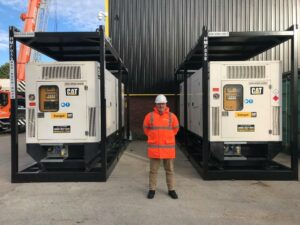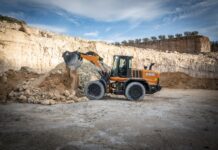When selecting temporary power for your site, choosing the number of generators to rent is not as simple as it sounds. Making this decision means factoring in your load requirements early on and determining what equipment will provide the necessary power for your site.
Here Karl Law, Applications Engineer at Energyst UK & Ireland, explains how you can make the right decision when selecting the number of temporary generators to hire.

Load requirements
The first step is knowing your site’s load requirements and the power you expect the unit to consume, this is called the site load profile. You can determine the total load by making a list of all the equipment that needs to be powered and calculating the total consumption of everything from sockets to pumps and motors, this is called the maximum demand. This will also help you identify the different load types on your site —including inductive, capacitive, and resistive loads.
You will also need to determine whether these loads are constant or intermittent. Will they have a high start followed by a low running load? If the load is constant then a single generator maybe sufficient, but if it is the latter then running two or more units in parallel may be more effective.
Fuel consumption
Investing in diesel, HVO and other fuels is a necessary evil when hiring generators —it’s vital that you have enough in reserve to cover the entire rental period and accommodate fluctuations in demand. Although it’s intuitive to think more machines mean higher consumption, this isn’t necessarily the case. For example, if two generators are sized correctly and they are running at their optimum window of engine efficiency, which is usually around70 to 75 per cent, the consumption will be leaner than if a single machine was running close to 100 per cent load.
Whether you use one generator or several, it is best to avoid low loading where possible. Although it may be tempting to dodge higher fuel consumption, the units will still consume other fluids like oil, combustion will be poor, and they will run at reduced efficiency as a result. This means the rental partner may need to load bank your generators to test their performance, using more fuel than if you had chosen right the first time. A good rental partner like Energyst will support customers by weighing-up load requirements and consumption targets to recommend the perfect power solution.
Room for one more?
The addition of more generators often means more cabling, extension cords and ancillaries to ensure the units are connected and running safely. For sites like hospital basements and some data centers, space is often at a premium and more equipment means less room for the generators —introducing difficulties with airflow and access for maintenance.
However, a larger footprint is offset by the greater resilience that comes with having two units running parallel and the security of knowing that your site has an extra layer of protection from unplanned downtime. If you have a critical site that requires N+1 redundancy and you have the space, it may be better to have an additional generator or two to share the load with the primary unit.
Load requirements, fuel consumption targets and space are all important when deciding between one temporary genset or multiple sets. You can only make this choice once you have considered your application needs, and a good rental partner will help you plan for temporary power by recommending a site-specific solution.
For more information and guidance on choosing a temporary generator set, click here.
















